How to prepare for Google SGE: Actionable tips for SEO success
Curious how Search Generative Experience will impact your organic traffic? Here’s what we know – and don't know – so far, and how to prepare.
While there are some reasonable assumptions of how Search Generative Experience (SGE) might affect our sites, others are not so realistic.
This article highlights:
- Theories about SGE’s traffic impact.
- What we know so far.
- What we don’t know yet.
- Things to avoid.
- Ways to prepare for SGE.
Theories on SGE’s potential traffic impact
SGE will undoubtedly impact organic search, with both positive and negative consequences, if it launches as it currently stands.
But how big will that impact be?
It is reasonable to assume that we could see a decrease in organic traffic of up to 30% – similar to how featured snippets impact some search results. This depends on the niche, business model and keyword types.
With that said, there is no magic number that can be generalized.
If there is no AI overview for the query, the impact will be close to zero.
If users are prompted to create an AI overview, a certain portion will follow through and create one.

However, creating this overview takes time, and general users won’t immediately adopt this behavior.
If your site gets an auto-generated AI overview but doesn’t appear in the response, expect a negative impact on your traffic. If you do appear, the impact will be less severe.
However, the human eye focuses more on things that appear on the left side, at least in countries where people read from left to right. So, the left part of the overview is probably more important.
Currently, sources are displayed on the right side, and there are small dropdown arrows in the response itself to signal interaction, which also reveals sources used for the response.
As such, regular organic results will be pushed down just like if any other SERP feature (i.e., ads) appears above them.
It’s fair to say that Google has less pressure to release the SGE to the general public because ChatGPT is losing steam.
Google is known for sticking to plans and trying to make its products work. Google doubled down on SGE in their earning’s call. And, if Google+ is any indicator, it would take quite some time for Google to kill SGE.
Google is continuing to invest in cloud technology to find growth opportunities. But right now, search advertising revenue is too important to risk making mistakes.
Another theory: The EU will get SGE much later than other regions, just like Bard.
Bard was officially released in March, but it took almost five months later to become available in the EU due to data privacy concerns.
This will serve as an opportunity for a part of the SEO community to observe what happens in first markets and to adapt accordingly.
While a lot of talk focuses on the negative impact on traffic, there are definitely some benefits.
- Ecommerce queries for products will see a spike as products are prominently displayed in the AI overviews.
- Great product images will likely have an impact on CTR, just like a good thumbnail on YouTube or attractive images in general.
- It is also very possible that SGE will lead to more zero-click searches when an answer is already given in a search result. We already saw this with featured snippets, though SGE might appear for more queries based on observations since its unofficial launch.
What we know about SGE so far
Those were a lot of theories, so let’s focus on things we actually know now.
SGE real estate will look different than the current SERP landscape
While an SGE overview is similar to other SERP features, like a featured snippet, it takes up much more space.
For many queries, the auto-generated overviews often fill the entire screen on desktop and require the user to scroll on mobile.

However, as you can see in the example above (for the query “how to cure depression”), the regular search features and ads also take up considerable screen real estate.
I doubt that Google will just show fewer ads, but that is what we frequently see at the moment.
If ads are added to this, either above or below the AI overview, regular organic results will get pushed down more than they do now.
Just recently, Google started showing a new layout for SGE when an overview is automatically generated. There is only a small preview and a “Show more” button. It does not fill the entire above-the-fold area or show any images of the linked sources.
Compare this AI snapshot for “credit card risk” from two different dates:
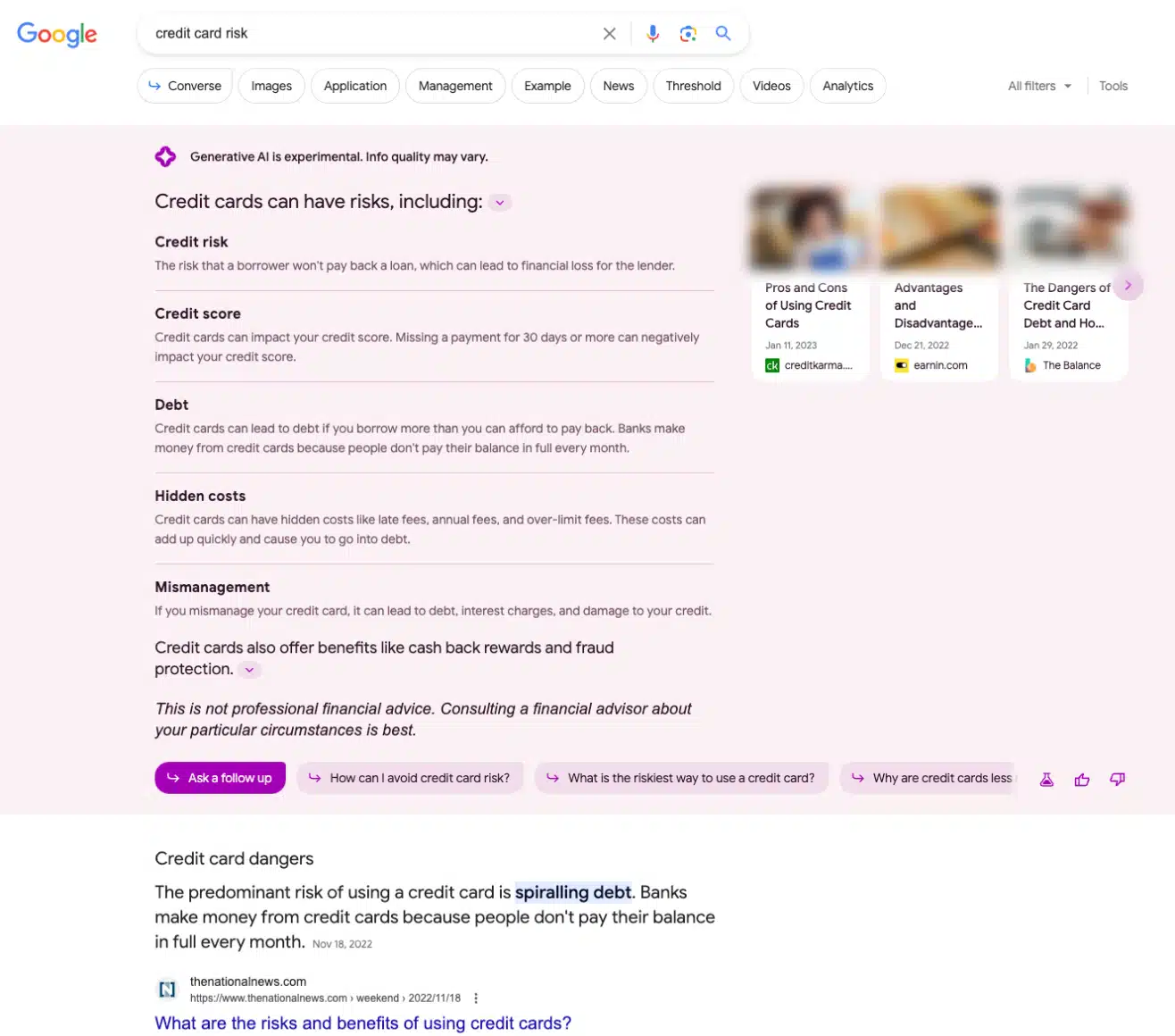
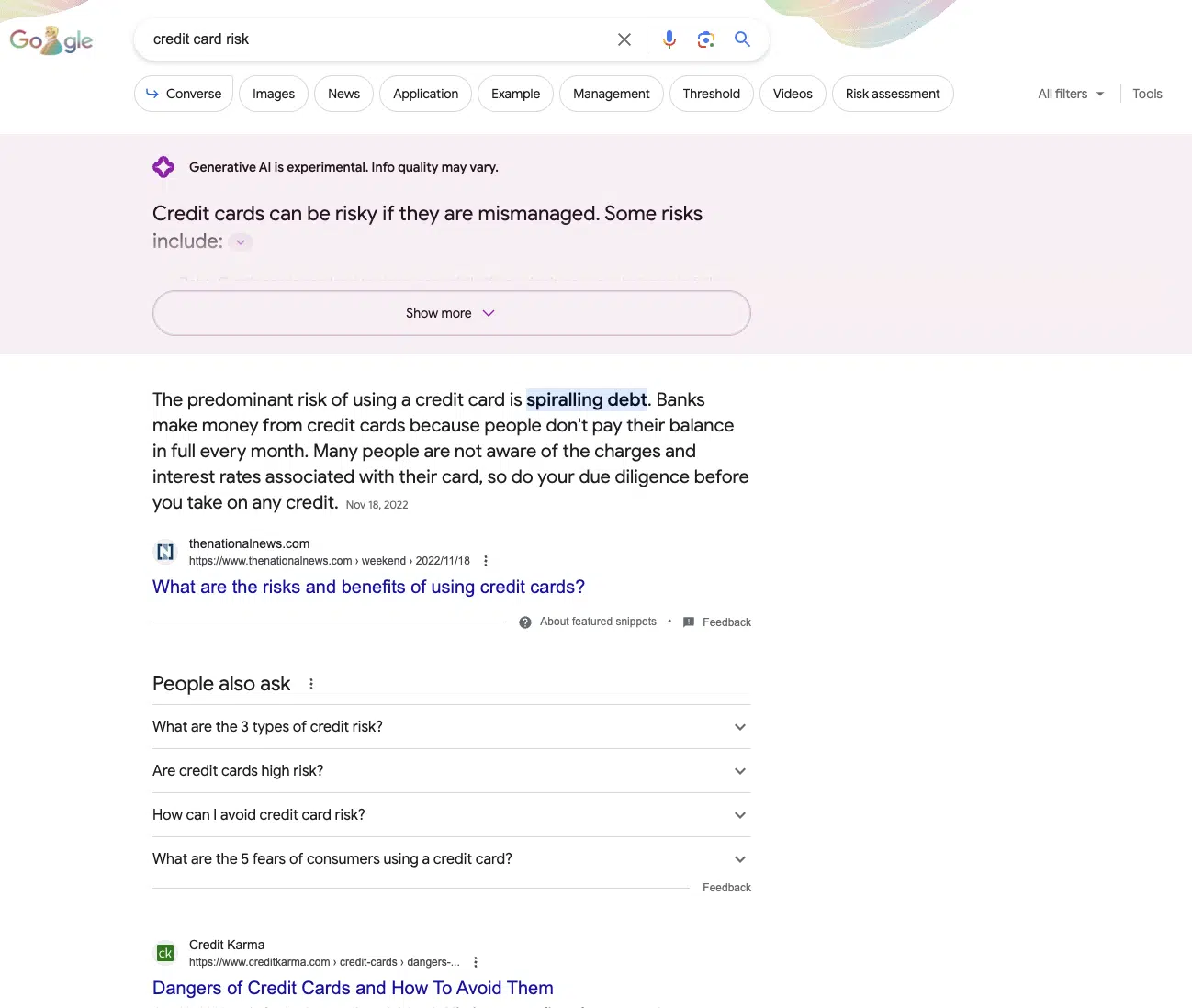
The first overview from late September was about 780px high, while the new one from early October is about 230px high – not even a third of the original size.
The organic traffic impact of the latter layout would probably be less than that of the former.
Images for the cited sources will likely impact CTR
Like good YouTube thumbnails, attractive images get a higher CTR than less attractive images.
For the cited sources, this has implications for not only getting an image to show up but also being attractive for users to click on.
Consider this an avenue for optimization: show exeption images in the overview that aim to stand out against the rest.
If an AI overview is presented, CTRs of regular organic results might drop
Assuming your site does not appear in the AI overview but is highly ranked in the regular organic results, your CTR will drop.
This is natural and a no-brainer, as everything above the fold is more important on both websites and in search results.
Like any SERP with many SERP features, the CTR is affected by their appearance and placement.
Currently, there are fewer ads in SGE than regular search
In my tests, I saw fewer ads in SGE compared to regular search. This is backed by other research from Moz and Insight Partners.
These tests and studies were conducted in September, but just like Google testing the new layout, I often saw more ads appearing over time.
You can be sure that Google is testing this as much as possible to not jeopardize their search ad revenue.
Things change all the time in SGE
As recently as late August, it was confirmed that SGE would retain sources, due to user feedback.
But that is not the only thing that has changed. After watching SGE for months, here are some other developments I have observed:
- Queries that can trigger an overview (increasing and decreasing).
- Ecommerce category keywords not automatically generating an overview.
- YMYL queries getting more overviews which might be a sign that Google trusts the quality of SGE’s output.
- Local packs showing a variety of two-packs up to five-packs (the latter being the most frequent one).
- Number of ads slightly increasing.
- Ad placement more often above the overview.
- Size of the overview for the same query which changes all the time.
- SGE response layouts.
- Content of the overview on a single day (changes all the time).
This list could go on and on.
One important point about SGE is its dynamics. Overviews for the same query are rarely 100% similar.
What we don’t yet know about SGE
This brings us to things we actually don’t know.
Will the SGE stay this volatile?
AI overviews change often, and most of the time, the changes are drastic. See the following examples (both screenshots were taken just two weeks apart):
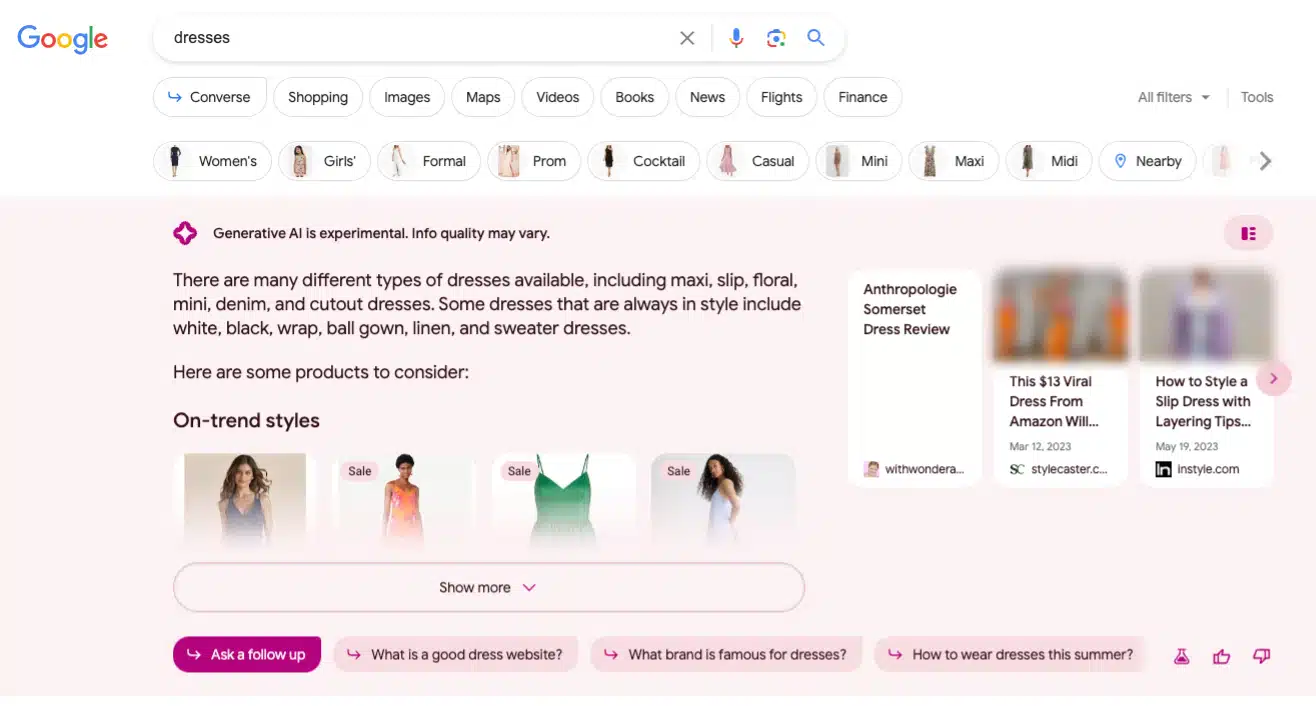

If your site wasn’t part of the first overview, it wouldn’t be half as bad as in the second overview, which is more than twice as big.
We simply don’t know if this will be normal for SGE, so any concrete calculations are pretty useless, especially if Google changes to a different layout, as mentioned before.
Will we ever get official data on SGE?
This is a complicated question with big implications. I’m sure the SEO community will develop ways to track changes in SGE over time.
There are already some suggestions for what you can do, which I will discuss in this article’s last chapter.
Microsoft promised to bring Bing Chat data into Bing Webmaster Tools.
While they delivered on that promise – albeit later than first announced – what we got is quite disappointing.
Both web and chat data are merged together with no filtering capabilities, making this data useless.
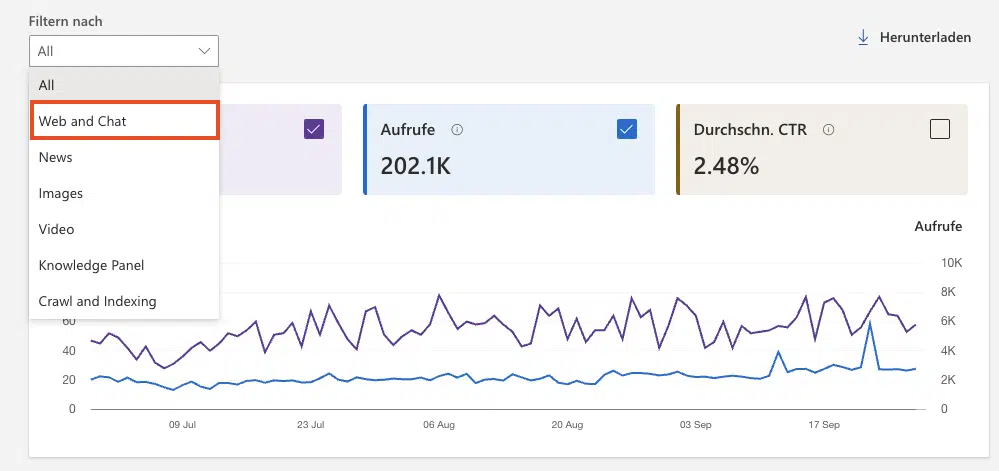
Why would Microsoft do this? Perhaps Bing Chat numbers are negligible, which is bad for PR.
My guess is that it will be many months after launch before we get data on SGE in Google Search Console.
Will there be ways to scale data collection on SGE?
Yes, even without official data, I’m sure SEO tool providers and smart people in the community will find ways to make them accessible.
But once again, it will take some time.
How exactly do we become part of the AI overview?
No one can say this with 100% certainty. From my observations in looking at informational queries especially, a reverse-engineering approach seems to work.
Try to see what kind of content is in the overview and what angle is covered, then find a way to present that information as clearly as possible.
However, as mentioned before, SGE elements change constantly – the angle, the answer to the same type of headline/question, and even the sources.
Let’s hope Google will provide more detailed information soon. Until then, we SEOs will have to test and see what works.
What kind of CTR can we expect if we get into the AI overview?
This is a tricky one. If we assume that every query generates the same type of snippet – with the same size, layout, etc. – then I would think that the CTR will be lower than for featured snippets.
But this cannot be generalized. However, it’s safe to say that it would be lower than the current number one spots for informational queries, where the CTR often ranges between 25-30%.
Things to avoid
There are quite a few things I would advise against, whether the reader is an SEO agency, freelancer, or even a company wondering, “What can I do to prepare for and/or mitigate the effects of SGE?”
A few things summarized from this article:
- Volatility is high.
- Scalability in any framework is questionable at the moment.
- We have no official data and don’t know how users will interact with the new features.
To illustrate how useless any model for measuring SGE impact can be, just look at the various screenshots I provided here.
To double down on this, a colleague and I did an experiment on volatility.
Imagine two people in the same VPN searching for the same query at the same time: The result should be the same, right?
We looked at 10 different queries and checked their SGE response three times on the same day at the same time.
Out of a total of 60 observations, here’s what we found:
- The average sources cited overlap was 57% – meaning on average less than two out of three sources overlap from one observation to another, so in less than 1/3 of our observations the same sources were used.
- There was only one case where the content differences were zero.
- The average content difference is at least medium* in 12 out of 30 comparisons.
- In only one of 60 observations we saw ads above the SGE response, even though some keywords that we selected feature top ads above organic results in regular Google search (much less than we recently observed).
*Differences
- Small: Only very small text differences, but some layout.
- Medium: Atleast small text differences and small changes in layout.
- Big:Text differences and big changes in layout.
Here is a direct example of the query “pros and cons of electric cars.”
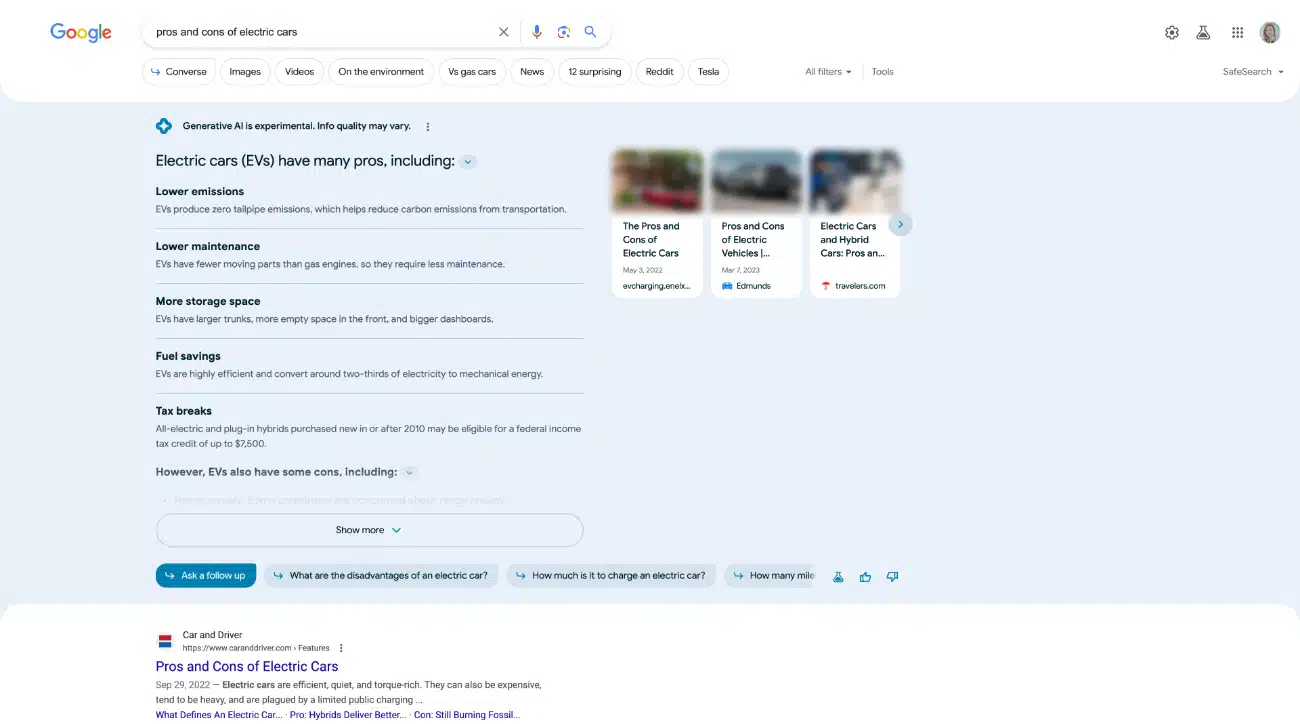
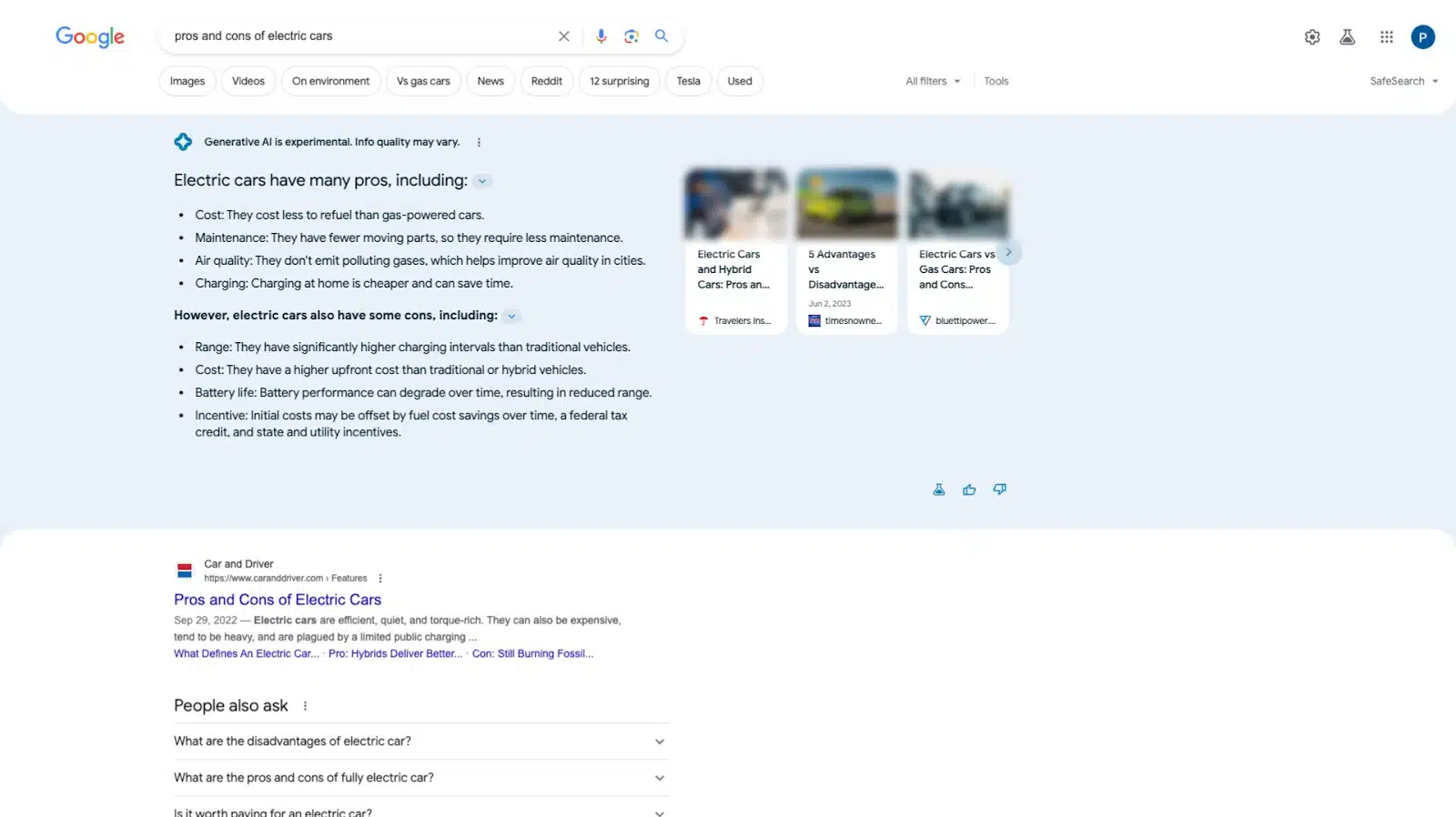
This was classified as “big differences” because:
- The text differs.
- The layout is different and one takes up way more space, especially when expanded.
- All visible sources are different.
This was a fairly small sample. However, we regularly monitor SGE queries and compare the results over time.
The results of this test are no different than our other observations – SGE is as volatile as some cryptocurrencies.
There is literally very little value in investing a lot of time in models and frameworks to project traffic loss. All you need to know is that SGE will have an impact.
If your business model and current organic traffic is mostly informational, you can expect a bigger impact than if you were an ecommerce site.
But no one knows how big that impact will be, and numbers ranging from -95% to +200% for the same site are not very helpful.
What you can do now to prepare for SGE
Focus on the things that have an SEO impact today.
While I always say to stay vigilant and keep an eye on new developments, we should not let shiny new things distract us from what is happening right now.
There are opportunity costs associated with things you do, and the opportunity cost of investing a lot of time in SGE is much higher than improving your SEO now and preparing for changes when we know more.
You can accurately measure what you pay by doing things later. This is one of the best arguments, in my opinion.
It’s like compound interest. If you publish valuable content today, it can start to work and bring in more revenue than if published later.
Dig deeper: Why next year’s SEO results depend on your SEO work this year
What I suggest you do instead of obsessing about the possible effects of SGE is the following:
- Work on things you know will have an impact now and in the future.
- Make sure you have attractive images in your content to be displayed in SGE.
- Put important words that make users click early in your titles.
- Monitor some important keywords in SGE.
- Always save screenshots with the same screen resolution.
- Capture the HTML so you can compare not just visual changes.
- Try to see overlap in what cited sources do well and corroborate like you would for featured snippets.
- If you are from the EU or countries that might not get SGE immediately. Watch the impact in first markets and learn from that.
- Wait and see.
The key takeaway?
Don’t become overly fixated on SGE. Avoid listening to people trying to sell you SGE-related solutions.
No one, except Google, knows the extent and impact SGE has on organic search.
Opinions expressed in this article are those of the guest author and not necessarily Search Engine Land. Staff authors are listed here.
Related stories
New on Search Engine Land